Contact with Stockhausen by Réjean Beaucage
/ December 12, 2005
Version française...
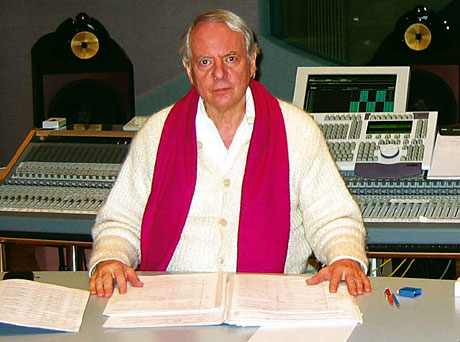
Many observers of the music scene consider Karlheinz Stockhausen the greatest living composer. In the early fifties, he led the post-serial avant-garde, along with
Pierre Boulez. Stockhausen developed the idea of serialism, pushing it to the
point where he created the super-formula. This giant concept governs works such
as his twenty-nine-hour opera cycle Licht (1977-2003) and each of the
highly varied segments that make up the work. He was a pioneer of electronic
music (Studie I, 1953), mixed music (Kontakte, 1959-60), spatial
orchestral music, (Gruppen, for three orchestras, 1955-57), intuitive
music (Aus Den Sieben Tagen, 1968), and many more. His catalogue
contains over 200 works.
Stockhausen turned seventy-seven on August 22, 2005. LSM
talked with him in early September, mainly aboutKontakte, his work for
piano, percussion and tape, to be presented this month by the SMCQ (Société de
musique contemporaine du Québec).
LSM: Surprising as your early Klavierstücke (Piano
Pieces, 1952) may have been for the first audiences, they were
nevertheless works of a composer who was also a pianist. Then, in 1953, you didStudie
I, followed byStudie II in 1954, both studies that already
demonstrated an astounding mastery of the apparatus needed for constructing
what was then the very new medium of electronic music.
KS: When composing these works, I wanted to
organize all the various sounds according to predetermined proportions. Based
on this, it was normal to "compose" the timbres (klangfarben) as well. I
had already done a first study in concrete musici in Paris in 1952--a very
simple thing, based on piano sounds that I had cut up, transposed, and so on.
After that, I was able to begin working with pure sound at the Nordwestdeutsche
Rundfunk (NWDR) electronic studio in Cologne. I understood what you could do
with sinusoidal waves thanks to Professor Meyer-Eppler of Bonn University, with
whom I studied. He taught phonetics and acoustics and had already written a
very important book on the production of electric sounds, Elektrische
Klangerzeugung [1949]. I understood that instrumental and vocal sounds
are built on partials [harmonic sounds].
LSM: What strikes us most, especially when listening
to the electronic version of Kontakte (1959-60), is the strange
beauty of these sounds--totally new at the time you invented them. I
don't think you meant to make "beautiful music" when you composed the Klavierstücke,
but what about Kontakte?
KS: Well, I'm the one who did it, and of
course at the time I wasn't basing myself on any tradition. You can't change
the timbres of a piano, but for Kontakte I manufactured the sounds and,
naturally, I used those that pleased me most. Still, there is a certain
resemblance in Kontakte to familiar timbres--like percussive timbres.
From the start I aimed at synthesizing abstract and concrete sounds. "Abstract
sounds" sound like nothing we know of, whereas "concrete sounds" remind us of
metal, wood, strings, and skin. Kontakte is therefore a synthesis of
abstract and concrete.
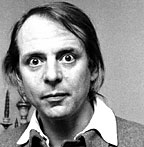 LSM:
There are two versions of Kontakte--one for tape only
(four-track), the other a mixed version, with a percussionist and
pianist added. Had you decided on doing two versions from the start? LSM:
There are two versions of Kontakte--one for tape only
(four-track), the other a mixed version, with a percussionist and
pianist added. Had you decided on doing two versions from the start?
KS: Yes. I began by working at the Cologne
Radio, with three percussionists who performed three variations of the music on
tape, but the result wasn't very convincing. Then I wrote out all the details
of a score for pianist and percussionist that became the second version. The
work was created in May 1960 and I felt it would be better if it weren't heard
only from loudspeakers but also from two musicians with whom I'd worked for
several years--David Tudor on piano and Christoph Caskel on percussion.
LSM: How was it received?
KS: Well, half-and-half, as usual. No, in
fact there were more people who didn't like it. Moreover, they were most
unpleasant to me about it. For example, Karl Amadeus Hartmann, the extremely
influential composer and president of the German section of the International
Society for Contemporary Music, passed by me on leaving the hall and said, "Scheißen
Stücke!"-- "A piece of shit!"--I was really hurt.
LSM: And yet it represented such a great advance for
music. The SMCQ has presented the mixed version three times so far, in 1978,
1983, and 1993. It sounds new each time we hear it.
KS: Especially with good performers!
Currently I have three duos who perform it and who are extraordinary.
LSM: Are you planning to record them?
KS: No, because we already have the Kontarsky
and Caskel from 1968ii, and I don't want to make several recordings of works
that are already available. There's this duo, for example, a Polish
percussionist and a Korean pianist. They're so good that I gave them first
prize last year at the end of my summer course.
LSM: I know, having consulted several of your scores,
that your writing can be rather difficult for a performer to decipher.
KS: That depends only on the time one wants
to devote to it. On the contrary, I think I'm very clear . . . A work like Kathinka's
Gesang [1982-83, for flute--see our October issue] requires an
excellent performer to spend, say, three or four months working on it. Kathinka
Pasveer, who gave the first performance, rehearsed it for six months! Now she
can teach it to other flautists, some of whom are from Canada, like
Marie-Hélène Breault, who came last summer and is returning next summer to
perform the work. This year was the eighth session of my summer courses. We had
134 excellent musicians from 20 countries. There were some 30 composers, over
twenty performers, a dozen musicologists and some music-lovers. And the nine
musicians who teach here are really fantastic! I'm taking advantage of the
opportunity to invite Canadian musicians to come and see us, especially
singers.iii
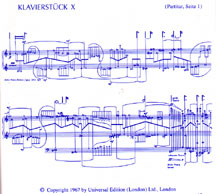 LSM:
You write very specific details in your scores that might be impossible to
play--for example to place a chord on the piano with different dynamics for
each finger . . . If I've understood correctly, you feel that the performer
must try to render the details asked for to the utmost extent of his or her
capacities, and this is what makes a satisfying performance. It that right? LSM:
You write very specific details in your scores that might be impossible to
play--for example to place a chord on the piano with different dynamics for
each finger . . . If I've understood correctly, you feel that the performer
must try to render the details asked for to the utmost extent of his or her
capacities, and this is what makes a satisfying performance. It that right?
KS: That's only half the story . . . The
other half if that, if you really want to perform these works, you have to
study them with those who have already done so and have spent many months with
me for this purpose. I want to establish a new learning tradition, where young
performers learn from the masters because scores can in fact become
undecipherable. They need to be demonstrated, and that's why we have teaching
sessions every summer. Some works are conceived so as to give the performer
more room for interpretation. For example, last August I did a new recording of Für
Kommende Zeiten (For Times to Come, 1968-70) with the Group for
Intuitive Music from Weimar. The compositions are all text, no notes, and this
may appear to leave infinite freedom of choice to the performer; when you work
on them, however, you realize that the freedom has its bounds, because, behind
the text is a vision of what would be the best possible interpretation, and
that's what you have to aim for.
LSM: There's another cycle of fifteen text
compositions in intuitive music, Aus Den Sieben Tagen (From
the Seven Days, 1968). Can we make a connection between those seven days
and the seven operas of the Licht cycle (Light--The Seven
Days of the Week, 1977–2003)?
KS: In several of the Licht scenes
there are moments in which the musicians have several choices and must make
individual decisions. This is the case in the flute and percussion version of Kathinka's
Gesang, for example. The six percussionists must follow a certain
direction and perform exact actions, but they can also make decisions that will
lead them in one direction or another, and they make these decisions freely.
That's a typical example.
LSM: Also, you very often call on the performer to give
the music a theatrical element. Why did you decide to introduce this element?
KS: This dates from Kreuzspiel (1951).
I've always paid particular attention to movement: how to come onstage, how to
leave, how to place a group of instrumentalists, and so on. There are several
levels in Kreuzspiel. The oboist has to sit on a podium 140 centimetres
high, and the percussionists also have to adopt certain special positions, and
so on. Kontakte is another good example. The movements of the pianist
and percussionist, who go to centre-stage then back to their instruments, are
all written in. I think that when we attend a musical performance the visual
aspect is as important as what we hear, it ia art too and that aspect
must also be composed.
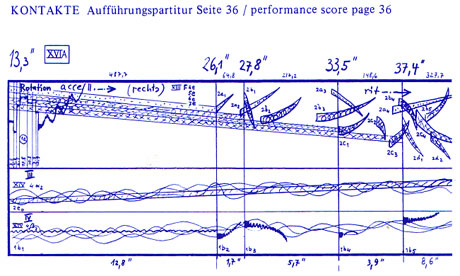 LSM:
Certainly, your greatest achievement in this respect is the Licht
opera cycle. Are you planning to have a complete performance of this seven-day
cycle?
KS: Yes. At the moment two organizations want
to do it. The European Arts Centre of Hellerau in Dresden wants to mount the
whole cycle in 2008. Udo Zimmermann will conduct. Also the committee
responsible for organizing the 2010 European Capital of Culture has announced
its intention of doing the same.
LSM: You've already said that a number of your
compositions were inspired by dreams--Helikopter-Streichquartett (Helicopter
String Quartet, 1992-93), for example.
KS: That's true of many of my works.
LSM: Do you think of yourself as a surrealist composer,
then?
KS: I recently gave six concerts in Norway,
where I performed Mittwochs-Abschied (Wednesday Farewell, 1996),
a work of electronic and concrete music, and I presented it as a music that was
not only surreal, but transreal, in the sense that it creates
expectations of events that could happen, but which turn into something
completely different, strange, but it isn't the strangeness that is transreal;
it is the miraculous nature of the musical transformation. Of course, there's a
lot of surrealism in my music.
LSM: You began a new cycle after finishing Licht
in 2003--Klang (Sound). It's surprising that you
haven't used this title before!
KS: Yes. In fact I'm surprised myself ! With Licht,
I concentrated for seventeen years on the meaning of light in music, based on
the seven days of the week (each of which has its own colour), the seven
planets of Antiquity, the constellations, and different appearances of the
divine. Finally, I asked myself why, as a musician, I was so interested in the
meaning of light when I should be interested in sound! That's what I'm doing
now, but based on the twenty-four hours of the day. Last May 5, Ascension Day,
we performed the first part of the cycle in the Milan cathedral: Ora Prima,
for organ, soprano, and tenor.
LSM: Isn't this your first work for organ?
KS: Yes. The work was commissioned for
performance in the cathedral, and I said to myself that it would be good to
learn how to use this instrument. It sounds really good! The only problem is
the eighteen seconds of reverberation in the cathedral . . . I had to find a
technical procedure for letting the audience hear the music and voices clearly
enough. I now have another commission from the cathedral for Ora Seconda.
It will be a piece for two harps, since I'm really keen to explore this problem
of long reverberation. I'd like to find new ways of colouring sound by using
this reverberation. I've almost finished the third hour of the cycle, which is
for piano only. I'm using the piano's natural reverberation. The subtitle is
"Natural Durations for Piano." It's almost a teaching work on using the piano
without the metronome beat, since I don't specify the length of the notes,
which should be the natural length of time for the instrument. It's a cycle in
itself that will complete a whole program. I've already finished fourteen
pieces in the cycle, out of a total of twenty-four.
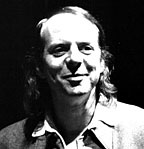 LSM:
It's fairly clear that time is among your major preoccupations. Are you also
planning a cycle on minutes, and another on seconds? LSM:
It's fairly clear that time is among your major preoccupations. Are you also
planning a cycle on minutes, and another on seconds?
KS: Yes, yes, it's true. I only hope I live
long enough after Klang to do it.
LSM: Are we talking of sixty pieces, each a minute
long?
KS: No, I'm not such a pedagogue as all that.
It's a theme. Just as Ora Prima lasts some forty minutes, and Ora Seconda
between twenty-five and thirty minutes. I'm not interested in the concept of
time in chronometric terms..
LSM: I know that you're mainly interested in time on a
grand scale: the rhythm of the planets, the stars . . .
KS: That's right.
LSM: You've also talked about the complex polyrhythms
of the human body. In the end, you're composing "naturalist" music.
KS: Yes--as I said, the subtitle of the third
hour of Klang is "Natural Durations for Piano." These durations are
determined by the intensity of attack, which differs with each performer. The
durations are physical and, so, natural.
LSM: Since Kontakte (1959-60) you've
done many works that mix acoustic and electronic instruments. What do you think
of the fact that symphony orchestras are playing the same way today as they did
in the nineteenth century?
KS: Yes, they need to work... But you cannot
speak anymore about "the musicians". There are only a handful of exceptional
soloists who, for a long time, will show other human beings what can be
achieved with the body. But orchestras are based on the concept of many people
playing together. This is an outmoded concept that takes absolutely no account
of the technological advances that could solve the basic problem, which is to
be heard. We don't need to have so many musicians playing the same thing.
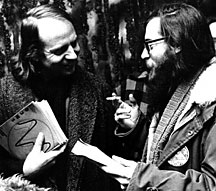 LSM:
You've replaced them with synthesizers . . . LSM:
You've replaced them with synthesizers . . .
KS: But even to have the typical effect of a
violin section takes only three musicians, and you can multiply this to get an
extraordinary sound. We don't need 120 musicians; it's ridiculous. I can do the
same thing with four loudspeakers!
LSM: What do you see as your contribution to the
history of music?
KS: Oh . . . I was an explorer. I discovered
a lot of acoustical and musical processes and new forms. Each of my pieces is a
new form, a new scheme, and that's what I continue doing. I think a composer
must be an artist above all, by which I mean not to let oneself be drawn
into making music for one's daily break, to make money, but first and foremost
to develop his art in breadth and depth. I believe we're responsible for the
continuing evolution of the language of music, and this is the most important
aspect of our work. And I think I can say that I've worked very hard in that
direction.
LSM: Are you still working more than eight hours a day?
KS: Yes, although it depends on where I am.
When I'm at home, it's usually nine hours a day.
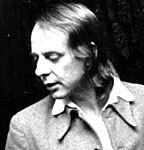 LSM:
The SMCQ has presented your music forty-seven times since its foundation in
1966, which makes you the most frequently played composer in its programs. LSM:
The SMCQ has presented your music forty-seven times since its foundation in
1966, which makes you the most frequently played composer in its programs.
KS: I remember my visits to the SMCQ well.
Maryvonne Kendergi used to come and see me and we would plan the programs
together. When I was there, I spent a lot of time with Canadian composers and I
knew some from the times of Messaien's class. Serge Garant and others were in
Paris at the same time as I was, and I saw them again in Montreal. But how is
Maryvonne, is she well?
LSM: Yes. She turned ninety a few weeks ago.
KS: Please give her my best wishes! Tell her
how much I appreciated the work she did.
No sooner said than done! *
[Translated by Jane
Brierley]
i Pierre Schaefer « discovered » musique concrète
in 1948 in the studios of the Radio Télévision Française. Stockhausen's Étude
(1952), Studie I (1953) et Studie II (1954) are available, with Gesang
des Jünglinge (1955-56) and Kontakte (1959-60) on «
Elektronische Musik », CD No. 3 of the complete works of the composer, which he
publishes himself (Stockhausen-Verlag : www.stockhausen.org).
ii Available on CD #6 of Stockhausen-Verlag. A 1960
version by David Tudor and Christoph Caskel is also available from Wergo
(6009-2).
iii All information on these summer courses is
available on the composer's website: www.stockhausen.org
Kontakte!
Second concert of the SMCQ's 40th
season
Tuesday, November 15, 2005, at 8 p.m.
Redpath Hall, McGill University
514 843-9305
Soloists: D'Arcy Philip Gray (percussion) and
Brigitte Poulin (piano)
Program:
Philippe Hurel, Tombeau in memoriam
Gérard Grisey (2000), for vibraphone and piano; Geof Holbrook, [new
work] Premiere performance;
Karlheinz Stockhausen, Kontakte (1959-60),
for piano, percussion and tape
Photo : Kathinka Pasveer
Photo : Bruno Massenet
Stockhausen, Mtl, 1971, photo : Bruno MassenetAvec
Raôul Duguay
Photo : Bruno Massenet
Avec Maryvonne Kendergi, photo : Bruno
Massenet
Version française... | 

